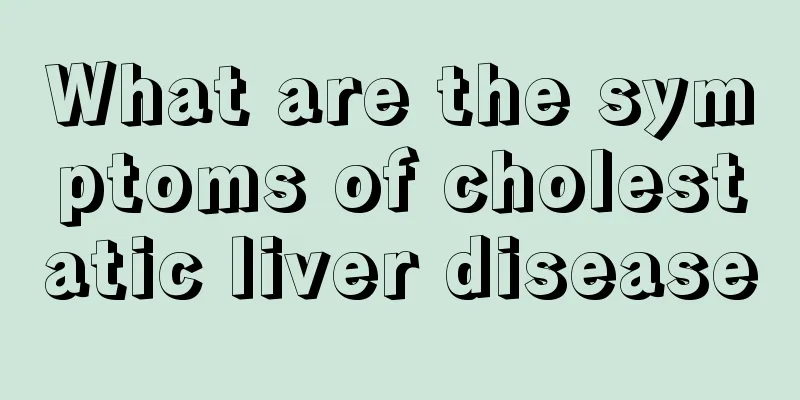What are the symptoms of cholestatic liver disease

|
Cholestatic liver disease usually presents with symptoms of jaundice or skin itching, while in the late stage of intrahepatic cholestasis, symptoms of liver failure or skin deposits forming xanthomas will appear, so the harm caused by these diseases is relatively serious. 1. Jaundice Jaundice is the most important clinical manifestation of intrahepatic cholestasis. Depending on whether the disease is chronic or acute, the severity of jaundice varies due to the disease and its cause, the severity of the disease, and the duration of the disease. It may occur before or after the itching. Jaundice occurs when the bile ductules or bile ductules in the liver become blocked due to various reasons, or when intrahepatic cholestasis occurs. As the pressure in the bile duct above continues to increase and the bile duct dilates, the bile ductules and bile ductules eventually rupture, and the bilirubin in the bile flows back into the blood, causing jaundice. In intrahepatic cholestasis, liver cells do not usually undergo necrosis, and the main symptom is increased conjugated bilirubin. Therefore, unlike hepatic jaundice, the skin is usually dark green or green-brown, and may have melanin deposition. The stool is grayish white due to the lack of bile in the feces, and urobilinogen is negative. In the early stages of jaundice, there are often no obvious symptoms. Chronic cholestasis progresses slowly, and common symptoms of hepatobiliary disease, such as fatigue and loss of appetite, are common at the beginning. 2. Skin itching may be the only symptom of cholestasis. It occurs due to the increase in the concentration of bile acid in the blood. The accumulation of bile acid in the body stimulates the sensory nerve endings of the skin. Patients with long-term cholestasis may experience significant itching due to the deposition of bile acid in the skin, and the degree of itching may not be parallel to hyperbilirubinemia. Persistent itching is a reliable clinical feature. Mental stimulation or infection every night makes the itching worse, and in severe cases, it affects sleep. When liver failure occurs in the late stage of intrahepatic cholestasis, the irritation to the skin is reduced due to reduced bile acid synthesis, so the itching is reduced or disappears. Generally, jaundice caused by intrahepatic cholestasis is milder than extrahepatic complete obstructive jaundice, and the skin itching is not as severe as extrahepatic jaundice. Pruritus may coexist with jaundice or exist alone, or it may appear several months after jaundice. 3. Xanthomas are formed by lipid deposition in the skin, and the incidence rate varies depending on the cause. For example, xanthomas occur in 50% of cases of primary biliary cirrhosis, and their occurrence is related to increased blood lipids, especially cholesterol levels. It is a long-term and severe manifestation of intrahepatic cholestasis. When cholesterol continues to increase to 20.8mmol/L for more than 3 months, xanthomas may form on the skin. It often occurs in the inner canthus of the eye or the folds of the palm, and also often occurs in the wrist, elbow, ankle, arm and perineum, and may appear as multiple nodules, the so-called xanthoma spots. When cholestasis is relieved or liver failure occurs in the late stage, the synthesis of blood lipids and cholesterol will decrease, and the tumor may shrink or even disappear. |
<<: What are the causes of cholestatic cirrhosis?
>>: Is cholestatic liver disease contagious?
Recommend
Can endometrial cancer be cured at the age of 60?
Patients with endometrial cancer aged 60 years an...
Closed comedones
The skin on the face is sensitive and most prone ...
What kind of work can I do when I am pregnant?
After some women become pregnant, they will lie i...
What should I do if my nails are damaged? How should I treat them?
If your nails are damaged, you should first find ...
Are sesame oil and pepper oil the same?
In our lives, many people prefer to eat sesame oi...
Which is the best hospital for treating bone cancer at present?
Bone and joint pain, bone lumps and movement diso...
What is the cause of mucus after defecation? Do you know these 3 reasons?
Many people find mucus in their stool after defec...
What are the risk factors for colon cancer? Is colon cancer hereditary?
Colon cancer is harmful to the health of patients...
What is the normal value of aspartate aminotransferase? What is the clinical significance?
Many people are not clear about what aspartate am...
What should I do if my feet hurt after walking too much?
Walking may be something people need to do every ...
Can belly button cupping kill people?
Cupping is common in traditional Chinese medicine...
How to effectively remove burn scars on arms
Burns are a common occurrence in life, and burns ...
Common causes of obstructive jaundice
Obstructive jaundice is caused by a blockage in t...
Dietary arrangements for brain cancer patients before and after surgery
Brain cancer patients should increase their nutri...
Can pregnant women eat prunes?
We all say that having an old person in the famil...









